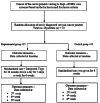A Randomized Controlled Trial on Pranayama and Yoga Nidra for Anxiety and Depression in Patients With Cervical Cancer Undergoing Standard of Care
- PMID: 38595893
- PMCID: PMC11002714
- DOI: 10.7759/cureus.55871
A Randomized Controlled Trial on Pranayama and Yoga Nidra for Anxiety and Depression in Patients With Cervical Cancer Undergoing Standard of Care
Abstract
Introduction Cervical cancer might intensify the psychological distress among patients with cervical cancer and the distress caused by the diagnosis and treatment. So, depression and anxiety are at higher levels in patients with cervical cancer. Yoga Nidra and Pranayama are thought to reduce the aftereffects of chemotherapy and radiotherapy potentially. So, in this study, we used the techniques of Yoga Nidra and Pranayama to evaluate their effect on patients with cervical cancer undergoing standard care. Methodology Seventy women with cervical cancer were randomized into experimental and control groups. The experimental group of patients with cervical cancer received 30 minutes of yoga intervention twice daily five days a week, for six weeks. The control group was given only the standard of care. The outcome measures were assessed using the Hospital Anxiety and Depression Scale (HADS) questionnaire. The assessment was done at baseline, second, fourth, and sixth weeks. Results The results of within‑group comparisons in both groups showed that there was a significant improvement in depression and anxiety scores, with P ≤ 0.05 being considered statistically significant. Between groups, analysis shows that in the preintervention, there was no difference between the yoga and control group as P > 0.05. After the yoga intervention, there was an enhancement in depression and anxiety scores. Conclusions The results of the study concluded that the Yoga Nidra and Pranayama module can be given as adjuvant therapy to the standard of care in patients with cervical cancer for treating the disease and treatment-related anxiety and depression.
Keywords: anxiety; cervical cancer; depression; yoga; yoga nidra.
Copyright © 2024, Nuzhath et al.
Conflict of interest statement
The authors have declared that no competing interests exist.
Figures





Similar articles
-
Efficacy of Yoga Nidra on Depression, Anxiety, and Insomnia in Frontline COVID-19 Healthcare Workers: A Pilot Randomized Controlled Trial.Int J Yoga Therap. 2023 Jan 1;33(2023):Article 3. doi: 10.17761/2023-D-22-00011. Int J Yoga Therap. 2023. PMID: 37327384 Clinical Trial.
-
Effect of Om chanting and Yoga Nidra on depression anxiety stress, sleep quality and autonomic functions of hypertensive subjects - a randomized controlled trial.J Basic Clin Physiol Pharmacol. 2022 Jun 13;34(1):69-75. doi: 10.1515/jbcpp-2022-0122. eCollection 2023 Jan 1. J Basic Clin Physiol Pharmacol. 2022. PMID: 35689170 Clinical Trial.
-
Yoga breathing for cancer chemotherapy-associated symptoms and quality of life: results of a pilot randomized controlled trial.J Altern Complement Med. 2012 May;18(5):473-9. doi: 10.1089/acm.2011.0555. Epub 2012 Apr 23. J Altern Complement Med. 2012. PMID: 22525009 Free PMC article. Clinical Trial.
-
Exploring the uses of yoga nidra: An integrative review.J Nurs Scholarsh. 2023 Nov;55(6):1164-1178. doi: 10.1111/jnu.12927. Epub 2023 Jul 25. J Nurs Scholarsh. 2023. PMID: 37489597 Review.
-
Effect of om chanting and yoga nidra on blood pressure and lipid profile in hypertension - A randomized controlled trial.J Ayurveda Integr Med. 2022 Oct-Dec;13(4):100657. doi: 10.1016/j.jaim.2022.100657. Epub 2022 Nov 11. J Ayurveda Integr Med. 2022. PMID: 36375220 Free PMC article. Review.
Cited by
-
Therapeutic potential of yoga nidra for chemo brain: a complementary and integrative perspective.Psychoradiology. 2025 Jul 28;5:kkaf020. doi: 10.1093/psyrad/kkaf020. eCollection 2025. Psychoradiology. 2025. PMID: 40837120 Free PMC article. Review.
-
Yoga Nidra: A Promising Complementary Therapy for Enhancing Cancer Care.Cureus. 2024 Sep 30;16(9):e70536. doi: 10.7759/cureus.70536. eCollection 2024 Sep. Cureus. 2024. PMID: 39479130 Free PMC article.
-
Factors influencing quality of life in early-stage upper gastrointestinal cancer patients in Nanchong city: a qualitative study.Am J Transl Res. 2024 Jul 25;16(7):3427-3436. doi: 10.62347/EZON6207. eCollection 2024. Am J Transl Res. 2024. PMID: 39114679 Free PMC article.
-
Exploring prehabilitation interventions for patients with gynaecological cancer undergoing radiotherapy: A scoping review.PLoS One. 2025 Mar 13;20(3):e0319518. doi: 10.1371/journal.pone.0319518. eCollection 2025. PLoS One. 2025. PMID: 40080513 Free PMC article.
References
-
- Current cancer epidemiology. Mattiuzzi C, Lippi G. https://pubmed.ncbi.nlm.nih.gov/31854162/ J Epidemiol Glob Health. 2019;9:217–222. - PMC - PubMed
-
- Cervical cancer. Cohen PA, Jhingran A, Oaknin A, Denny L. Lancet Lond Engl. 2019;12:169–182. - PubMed
-
- Global cancer statistics 2018: GLOBOCAN estimates of incidence and mortality worldwide for 36 cancers in 185 countries. Bray F, Ferlay J, Soerjomataram I, Siegel RL, Torre LA, Jemal A. CA Cancer J Clin. 2018;68:394–424. - PubMed
-
- Cervical cancer screening recommendations: now and for the future. Rayner M, Welp A, Stoler MH, Cantrell LA. https://www.cancer.org.au/clinical-guidelines/cervical-cancer/cervical-c... Healthcare (Basel) 2023;11 - PMC - PubMed
LinkOut - more resources
Full Text Sources
